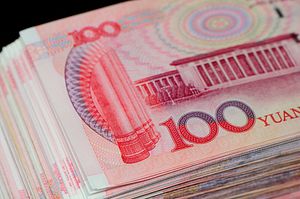As expected, the International Monetary Fund announced on Monday that China’s currency, the renminbi, will be added to the elite “Special Drawing Rights” (SDR) basket of currencies. The renminbi joins the U.S. dollar, the British pound sterling, the euro, and the Japanese yen in this club.
The announcement is a welcome bit of good news for Chinese leaders. This year has been particularly difficult for China economically, amid slowing overall growth rates and a highly volatile equity market. The IMF’s decision to recommend the renminbi for inclusion in the SDR is, if nothing else, a vote of confidence in the global importance of the renminbi and, concomitantly, in China’s enduring status as an economic superpower.
The People’s Bank of China, the country’s central bank, hailed the IMF’s decision. “We appreciate the hard work of the IMF management and staff in the SDR review, and the support of fund members,” the bank noted in a statement. “The inclusion of the RMB in the SDR basket will increase the representation and attractiveness of the SDR, and help improve the current international monetary system, which will benefit both China and the rest of the world.”
To make room for the renminbi, the IMF had to reweigh the relative composition of the SDR. Under the old SDR, the U.S. dollar carried a weight of 41.9 percent, the euro 37.3 percent, the yen 9.4 percent, and the British pound 11.4 percent. The new SDR basket sets the renminbi’s share at 10.92 percent, outweighing the yen and the British pound, which have been set to 8.33 and 8.09 percent respectively. In a telling sign of current geopolitical realities perhaps, the euro saw the greatest drop in the SDR basket to yield room for the renminbi — it now comprises 30.93 percent of the SDR basket. The dollar continues to sit high and mighty, having lost just shy of 0.2 points (it comprises 41.73 percent of the new SDR). The addition — and the new composition of the SDR basket — will take effect on October 1, 2016.
The SDR’s role in allowing the IMF to play its role as a lender of last resort is important. There’s a good deal of wonkery in how the relative values of the currencies comprising the basket set the terms of IMF loans (the Fund itself has a helpful fact sheet outlining some of the quantitative underpinnings of the basket). The renminbi’s inclusion hinged on it meeting two criteria. Namely, the IMF had to certify that the renminbi was both “widely used” and “freely usable.” The former was somewhat of a no-brainer given China’s massive footprint in global trade. Additionally, yuan-denominated cross-border transactions have grown in the past years, leading to the currency’s use outside of China’s borders.
The “freely usable” part of the equation was more fraught and the reason the IMF’s determination didn’t come much sooner. The IMF’s announcement isn’t entirely a surprise. As I discussed some weeks ago in these pages, the Financial Times had already reported that the IMF would most likely recommend the renminbi for SDR inclusion today (see the full post here). Additionally, in recent months, we’ve seen encouraging signs that the renminbi is becoming more “freely usable.” For instance, following a visit to China by the U.K.’s Chancellor of the Exchequer George Osborne earlier this autumn, London became the first overseas hub for renminbi-denominated Chinese sovereign debt. Chinese bond markets have also opened up recently to foreign institutional investors and central banks.
China, like most states, certainly values prestige in international affairs. Seeing the renminbi included in the same company as the dollar, the euro, the pound, and the yen will be a sign that China has “arrived.” At at time when doubts are widespread about the ability of the Chinese economy to sustain six-percent-plus quarterly GDP growth, this is a welcome sign. However, the renminbi’s SDR inclusion will do little to immediately convince investors that renminbi-denominated assets and securities are worth holding. That will depend more on China’s structural economic reforms (not to mention, increased policy transparency and better economic data).

































